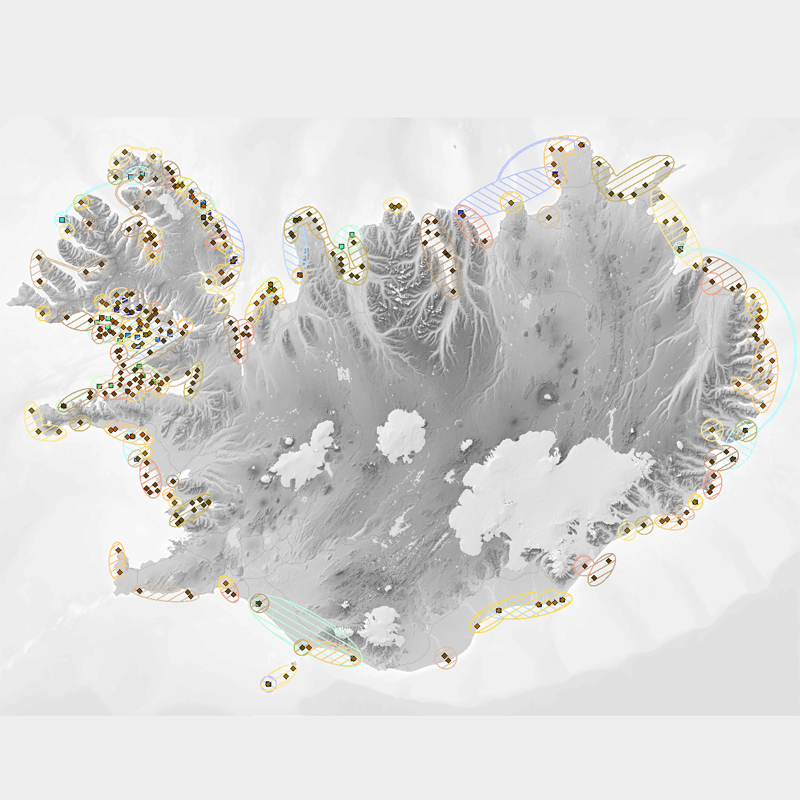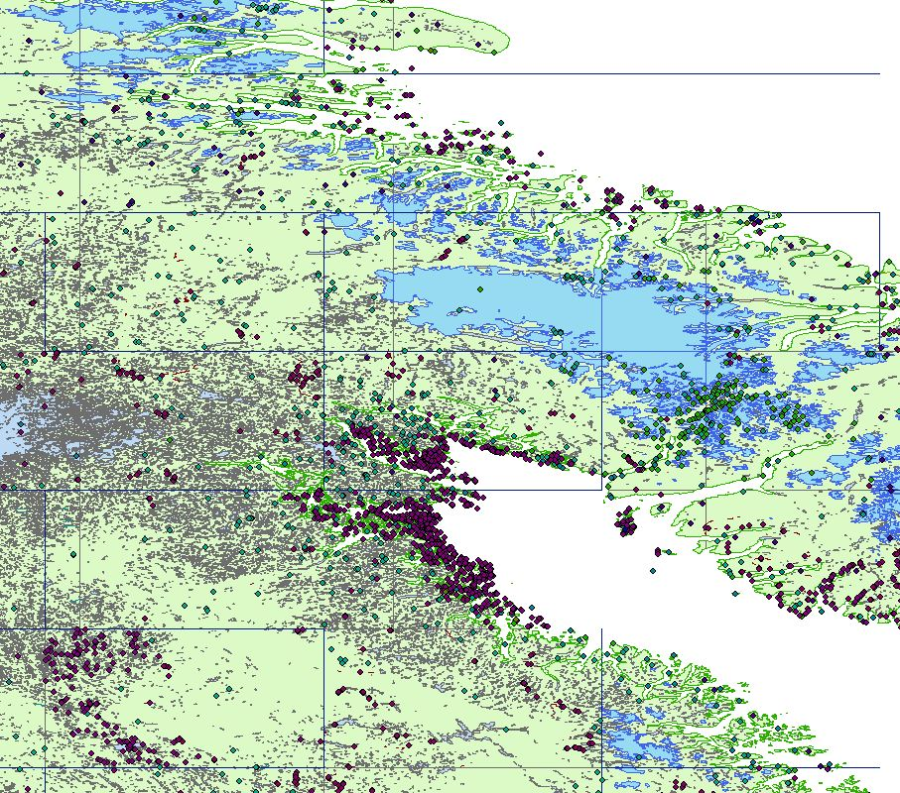250000
Type of resources
Available actions
Topics
Keywords
Contact for the resource
Provided by
Years
Formats
Representation types
Update frequencies
status
Scale
-
Energy class layer produced by EMODnet Seabed Habitats as an input layer for the 2019 EUSeaMap broad-scale habitat model. The extent of the mapped area includes the Baltic Sea, and areas of the North Eastern Atlantic and Arctic extending from the Canary Islands in the south to Norway in the North. The map of energy classes was produced using underlying wave and current data and thresholds derived from statistical analyses or expert judgement on known conditions. Detailed information on the modelling process for the 2016 is found in the EMODnet Seabed Habitats technical report and its appendices (Populus et al, 2017, link in Resources). We are working on an updated report for the 2019 version.
-
Layer showing the boundaries used to subset the modelling of EUSeaMap (2019) therefore streamlining the processing. Each region had a specific partner lead within the consortium: Celtic seas & Arctic - JNCC Iberian peninsula & Black Sea - Ifremer Baltic sea - GEUS Mediterranean - ISPRA
-
Shapefile showing areas where ice concentration in the Barents Sea in 2018 was on average more than 20%. The 20% threshold was derived from WMO ice classification and corresponds to "Very open drift ice". Data averaged by Ifremer and NIVA derived from CMEMS (Copernicus) ice concentration product (resolution 1km, temporal resolution 1 year- 2018). Used in EUSeaMap 2021 to create the Arctic mask layer as an input layer for the 2021 EUSeaMap broad-scale habitat model Created by the EMODnet Seabed Habitats project consortium. A report on the methods used in the 2021 version of EUSeaMap (Vasquez et al., 2021) and reports on previous versions (v2016 and V2019) are linked in Online Resources. Credit: Licensed under CC-BY 4.0 from the European Marine Observation and Data Network (EMODnet) Seabed Habitats initiative (www.emodnet-seabedhabitats.eu), funded by the European Commission.
-
Arctic mask shapefile produced by EMODnet Seabed Habitats as an input layer for the 2021 EUSeaMap broad-scale habitat model. Used in as a proxy to delimit the Arctic zone and it is used to classify shallow habitats into Arctic habitat classes as required by the EUNIS (V. 2019) habitat classification. The masks covers areas in the Barents Sea which are North of the polar front or where ice concentration exceeded 20% on average in 2018. The 20% threshold was derived from WMO ice classification and corresponds to "Very open drift ice". Created by the EMODnet Seabed Habitats project consortium. A report on the methods used in the 2021 version of EUSeaMap (Vasquez et al., 2021) and reports on previous versions (v2016 and V2019) are linked in Online Resources. Credit: Licensed under CC-BY 4.0 from the European Marine Observation and Data Network (EMODnet) Seabed Habitats initiative (www.emodnet-seabedhabitats.eu), funded by the European Commission.
-
Energy class layer produced by EMODnet Seabed Habitats as an input layer for the 2021 EUSeaMap broad-scale habitat model. The extent of the mapped area includes the Baltic Sea, and areas of the North Eastern Atlantic and Arctic extending from the Canary Islands in the south to Norway in the North. The map of energy classes was produced using underlying wave and current data and thresholds derived from statistical analyses or expert judgement on known conditions. This layer is the same as the input used in EUSeaMap 2019. A report on the methods used in the 2021 version of EUSeaMap (Vasquez et al., 2021) and reports on previous versions (v2016 and V2019) are linked in Online Resources.
-

This group of maps, which includes the CanMatrix and CanTopo collections, is now a legacy product that is no longer maintained. It may not meet current government standards. Natural Resources Canada's (NRCan) topographic raster maps provide a representation of the topographic phenomena of the Canadian landmass. Several editions of paper maps have been produced over time in order to offer improved products compared to their predecessors in terms of quality and the most up to date information possible. The georeferenced maps can be used in a Geographic Information System (GIS). In all cases, they accurately represent the topographical data available for the date indicated (validity date). The combination of CanMatrix and CanTopo data provides complete national coverage. • CanMatrix - Print Ready: Raster maps produced by scanning topographic maps at scales from 1:25 000 to 1:1 000 000. This product is not georeferenced. Validity dates: 1944 to 2005 (1980 on average). Available formats: PDF and TIFF • CanMatrix - Georeferenced: Raster maps produced by scanning topographic maps at scales of 1:50 000 and 1:250 000. These maps are georeferenced according to the 1983 North American Reference System (NAD 83). Validity dates: 1944 to 2005 (1980 on average). Available format: GeoTIFF • CanTopo: Digital raster maps produced mainly from the GeoBase initiative, NRCan digital topographic data, and other sources. Approximately 2,234 datasets (maps) at scale of 1:50 000, primarily covering northern Canada, are available. CanTopo datasets in GeoPDF and GeoTIFF format are georeferenced according to the 1983 North American Reference System (NAD 83). Validity dates: 1946 to 2012 (2007 on average). Available formats: PDF, GeoPDF, TIFF and GeoTIFF
-

Gagnasafn (GDB) NI_D25v_selalaturVidStrendurIslands_2.utg.: Útbreiðsla landsela (Phoca vitulina) og talningagögn 1980-2018. Útbreiðsla útsela (Halichoerus grypus) og talningagögn 1982-2017. [Seal haul-outs around Iceland]. Fjögur flákalög sem sýna kortlagningu 430 landselslátra á 93 talningasvæðum (ni_d25v_landselir_1980_2018_selalatur_fl, ni_d25v_landselir_1980_2018_talningarsvaedi_fl) og 86 útselslátra á 19 talningasvæðum (ni_d25v_utselir_1982_2017_selalautur_fl, ni_d25v_utselir_1982_2017_talningarsvaedi_fl). Talningagögn segja til um fjölda sela á hverju talningasvæði. Selir eru taldir á nokkurra ára fresti og gefur ágæta mynd af breytingum í stofnstærð og umfangi selalátra. Landselir eru taldir síðsumars en útselir að hausti. Nánari skýringar á aðferðum við selatalningar og stofnmat er að finna í Fjölriti 56. Látur eru strandsvæði sem selir leita á til að kæpa, sinna uppeldi kópa, hafa feldskipti og hvílast. Orðið selalátur vísar hér til smæstu samfelldu spildanna þar sem selir halda til. Talningasvæði er aftur á móti víðtækara safnheiti sem oftast nær yfir mörg smærri selalátur. Nákvæmni kortlagningu selalátra miðast við mælikvarða 1:25.000, en nákvæmni talningasvæða er um 1:250.000. [General overview of the seal haul-out locations around Iceland for harbour seals (Phoca vitulina) and grey seals (Halichoerus grypus). The harbour seal population has been monitored with direct counts (aerial censuses) since 1980 and the grey seal population since 1982. Both feature classes 'latur' show the haul-outs (Icelandic: látur) for each species. The haul-outs are grouped into counting zones (Icelandic: talningarsvæði) and both feature classes 'talningarsvaedi' show the associated population counts.] .
-

The VMap1 collection is a legacy product that is no longer supported. It may not meet current government standards. VMap1 is a vector digital topographic reference product developed by Natural Resources Canada (NRCan) and The Department of National Defence (DND). VMap1 complies with international military specifications vector map, level 1. There are 24 VMap1 libraries covering the Canadian territory. The National Topographic Data Base (NTDB) at scale of 1:250 000 is the main source used to populate the Canadian VMap1 Libraries. Administrative Boundaries from Statistics Canada are used to add international borders, provincial and Indian reserve limits. NRCan paper maps at scale of 1:250 000 and the information in the Canadian Geographical Names Data Base (CGNDB) are used to capture the names. The JOG (Joint Operations Graphic) paper maps were used by DND for the production of libraries 37, 38 and 66. Topographic features mainly from the NTDB have not been updated. VMap1 is published once and no product revision is planned.
-
Energy class layer produced by EMODnet Seabed Habitats as an input layer for the 2023 EUSeaMap broad-scale habitat model. The extent of the mapped area includes the Baltic Sea, and areas of the North Eastern Atlantic and Arctic extending from the Canary Islands in the south to Norway in the North. The map of energy classes was produced using underlying wave and current data and thresholds derived from statistical analyses or expert judgement on known conditions. This layer was updated in EUSeaMap 2023 using a new wave Kinetic energy at the seabed layer for the European Shelf area. A report on the methods used in the 2023 version of EUSeaMap and reports on previous versions (v2019 and V2021) are linked in Online Resources.
-
Energy class layer produced by EMODnet Seabed Habitats as an input layer for the 2016 EUSeaMap broad-scale habitat model. The extent of the mapped area includes the Baltic Sea, and areas of the North Eastern Atlantic and Arctic extending from the Canary Islands in the south to Norway in the North. The map of energy classes was produced using underlying wave and current data and thresholds derived from statistical analyses or expert judgement on known conditions. Detailed information on the modelling process is found in the EMODnet Seabed Habitats technical report and its appendices (Populus et al, 2017, link in Resources).
 Arctic SDI catalogue
Arctic SDI catalogue